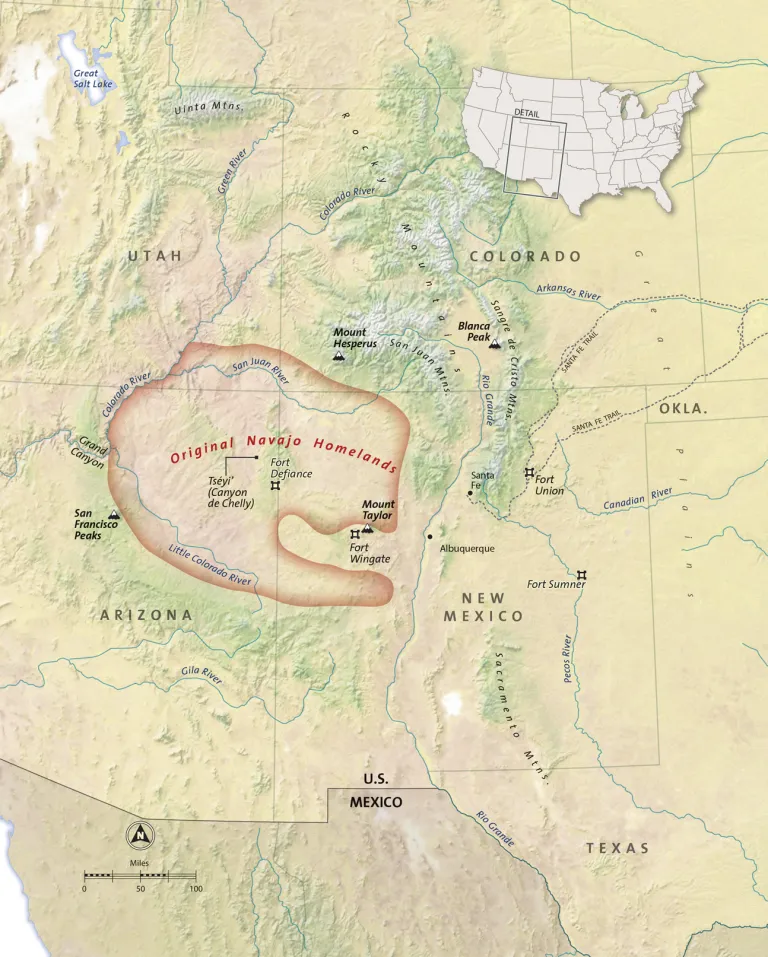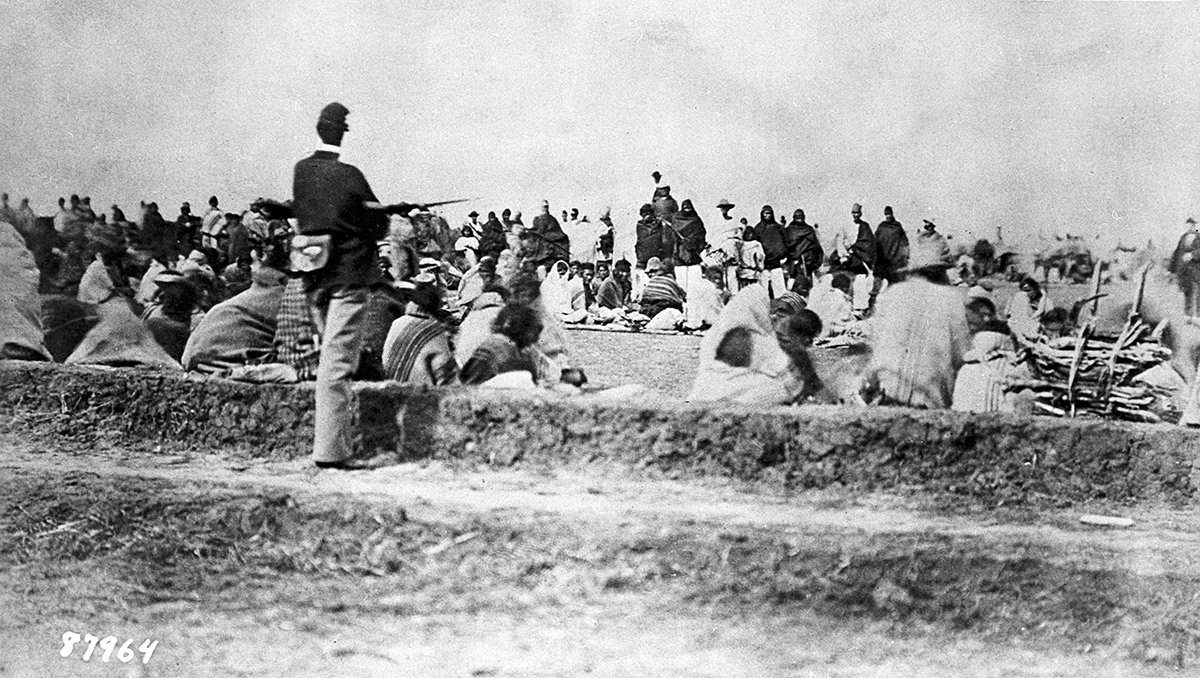More languages
More actions
(Created) Tag: Visual edit |
Charhapiti (talk | contribs) No edit summary |
||
| (2 intermediate revisions by one other user not shown) | |||
| Line 1: | Line 1: | ||
{{Infobox country|name=Navajo Nation|native_name=Naabeehó Bináhásdzo|image_flag=Navajo flag.svg|image_coat=Seal of the Navajo Nation.svg|capital=Tségháhoodzání|government_type=[[U.S.]] [[colonial]] occupation|area_km2=|population_estimate=399,690}} | {{Infobox country|name=Navajo Nation|native_name=Naabeehó Bináhásdzo|image_flag=Navajo flag.svg|image_coat=Seal of the Navajo Nation.svg|capital=Tségháhoodzání|government_type=[[U.S.]] [[colonial]] occupation|image_map=Navajo map.png|map_width=260|area_km2=|population_estimate=399,690}} | ||
The '''Navajo Nation''' is a nation in North America that is occupied by the [[United States of America|United States]]. | The '''Navajo Nation''' is a nation in North America that is occupied by the [[United States of America|United States]]. | ||
| Line 7: | Line 7: | ||
=== Early history === | === Early history === | ||
Several centuries before [[Settler colonialism|colonization]], the Navajo separated from other Athabaskans living in the subarctic and migrated south until reaching what is now the southwestern USA. Most of the Athabaskans remained in [[State of Alaska|Alaska]] and northwestern [[Canada]].<ref name=":03">{{Citation|author=[[Roxanne Dunbar-Ortiz]]|year=2014|title=An Indigenous Peoples' History of the United States|chapter=Follow the Corn|page=23|pdf=https://www.lcps.org/cms/lib/VA01000195/Centricity/Domain/10601/An%20Indigenous%20Peoples%20History%20of%20the%20United%20States%20Ortiz.pdf|city=Boston, Massachusetts|publisher=Beacon Press|isbn=9780807000403}}</ref> | Several centuries before [[Settler colonialism|colonization]], the Navajo separated from other Athabaskans living in the subarctic and migrated south until reaching what is now the southwestern USA. Most of the Athabaskans remained in [[State of Alaska|Alaska]] and northwestern [[Canada]].<ref name=":03">{{Citation|author=[[Roxanne Dunbar-Ortiz]]|year=2014|title=An Indigenous Peoples' History of the United States|chapter=Follow the Corn|page=23|pdf=https://www.lcps.org/cms/lib/VA01000195/Centricity/Domain/10601/An%20Indigenous%20Peoples%20History%20of%20the%20United%20States%20Ortiz.pdf|city=Boston, Massachusetts|publisher=Beacon Press|isbn=9780807000403}}</ref> | ||
=== Spanish colonization === | |||
In the 17th century, the Navajo supported a Pueblo revolt against the [[Monarchy of Spain (1516–1700)|Spanish]]. The Apaches, Hopi, and Utes also fought in the rebellion.<ref name=":032">{{Citation|author=[[Roxanne Dunbar-Ortiz]]|year=2014|title=An Indigenous Peoples' History of the United States|chapter=Sea to Shining Sea|page=125|pdf=https://www.lcps.org/cms/lib/VA01000195/Centricity/Domain/10601/An%20Indigenous%20Peoples%20History%20of%20the%20United%20States%20Ortiz.pdf|city=Boston, Massachusetts|publisher=Beacon Press|isbn=9780807000403}}</ref> | |||
=== U.S. colonization === | |||
[[File:Navajo Indian captives under guard, Fort Sumner, New Mexico.jpg|thumb|Navajo people at the Bosque Redondo concentration camp in the 1860s]] | |||
The U.S. [[Mexican–Statesian War|took over]] Navajo territory from [[Mexican United States|Mexico]] in 1848.<ref name=":1232">{{Citation|author=David Vine|year=2020|title=The United States of War|chapter=The Permanent Indian Frontier|page=149–54|city=Oakland|publisher=University of California Press|isbn=9780520972070|lg=http://library.lol/main/191568BFAC73F009132DB00ECD0F0F05}}</ref> During the [[Statesian Civil War|Civil War]], [[James Carleton]] became a brigadier general and put [[Kit Carson]] in charge of the Navajo. In March 1864, Carson forced 8,000 Navajo civilians to march 300 miles to a concentration camp at Bosque Redondo. A quarter of the Navajo population died before being allowed to return to their homeland in 1868.<ref name=":033">{{Citation|author=[[Roxanne Dunbar-Ortiz]]|year=2014|title=An Indigenous Peoples' History of the United States|chapter="Indian Country"|page=138|pdf=https://www.lcps.org/cms/lib/VA01000195/Centricity/Domain/10601/An%20Indigenous%20Peoples%20History%20of%20the%20United%20States%20Ortiz.pdf|city=Boston, Massachusetts|publisher=Beacon Press|isbn=9780807000403}}</ref> | |||
== References == | == References == | ||
[[Category:Nations]] | [[Category:Nations]] | ||
[[Category:Countries invaded by the United States]] | [[Category:Countries invaded by the United States]] | ||
[[Category:Indigenous People of the Americas]] | |||
Latest revision as of 12:26, 14 May 2024
| Navajo Nation Naabeehó Bináhásdzo | |
|---|---|
 | |
| Capital | Tségháhoodzání |
| Government | U.S. colonial occupation |
| Population | |
• Estimate | 399,690 |
The Navajo Nation is a nation in North America that is occupied by the United States.
History[edit | edit source]
Early history[edit | edit source]
Several centuries before colonization, the Navajo separated from other Athabaskans living in the subarctic and migrated south until reaching what is now the southwestern USA. Most of the Athabaskans remained in Alaska and northwestern Canada.[1]
Spanish colonization[edit | edit source]
In the 17th century, the Navajo supported a Pueblo revolt against the Spanish. The Apaches, Hopi, and Utes also fought in the rebellion.[2]
U.S. colonization[edit | edit source]

The U.S. took over Navajo territory from Mexico in 1848.[3] During the Civil War, James Carleton became a brigadier general and put Kit Carson in charge of the Navajo. In March 1864, Carson forced 8,000 Navajo civilians to march 300 miles to a concentration camp at Bosque Redondo. A quarter of the Navajo population died before being allowed to return to their homeland in 1868.[4]
References[edit | edit source]
- ↑ Roxanne Dunbar-Ortiz (2014). An Indigenous Peoples' History of the United States: 'Follow the Corn' (p. 23). [PDF] Boston, Massachusetts: Beacon Press. ISBN 9780807000403
- ↑ Roxanne Dunbar-Ortiz (2014). An Indigenous Peoples' History of the United States: 'Sea to Shining Sea' (p. 125). [PDF] Boston, Massachusetts: Beacon Press. ISBN 9780807000403
- ↑ David Vine (2020). The United States of War: 'The Permanent Indian Frontier' (pp. 149–54). Oakland: University of California Press. ISBN 9780520972070 [LG]
- ↑ Roxanne Dunbar-Ortiz (2014). An Indigenous Peoples' History of the United States: '"Indian Country"' (p. 138). [PDF] Boston, Massachusetts: Beacon Press. ISBN 9780807000403


